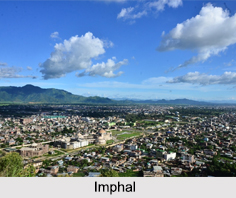 A bustling mini metropolis, Imphal is the capital city of the state of Manipur. The city is located at an elevation of 790 m and is central to the official, commercial and cultural activities of the state. The city is a major trade centre noted for its weaving, brassware, bronze ware, and other cottage industries.
A bustling mini metropolis, Imphal is the capital city of the state of Manipur. The city is located at an elevation of 790 m and is central to the official, commercial and cultural activities of the state. The city is a major trade centre noted for its weaving, brassware, bronze ware, and other cottage industries.
History of Imphal
Imphal was once the royal seat of the erstwhile kingdom of Manipur before the region came under the British rule. In the year 1944 during the time of World War II, Imphal was the site of a significant tactical victory for the Anglo Indian forces over the Japanese on the Burmese front of the War.
Demographics of Imphal
The city of Imphal is governed by the Municipal Corporation, which comes under the Imphal Metropolitan Region. According to the Census India reports of 2016, the total population within Imphal"s city limits was 4,268,243 or 4,277,196 including out growths. The average literacy rate in the city was over 90 percent, with male literacy being at 95 percent exceeding the female literacy rate, which was at 87 percent.
The dominant religion practised in the area is Hinduism with 70 percent of the inhabitants being Hindu. Other religions like Christianity, Sanamahism, Islam, Buddhism, Jainism and Sikhism, etc constituted the rest of the 30 percent of the total religious population.
 Climate of Imphal
Climate of Imphal
Located in extreme eastern India, Imphal experiences a humid subtropical climate with mild, dry winters and a hot monsoon season. The average annual temperature is around 21 degree Celsius with the month of July being the hottest, having a temperature of almost 30 degree Celsius. The month of January is the coldest, when the temperature drops to 4 degree Celsius. Imphal receives an average annual rainfall of 1581 mm with the month of June being the wettest. On 22nd May, 2009, the highest temperature of 35.6 degree Celsius was recorded and the lowest temperature of -2.7 degree Celsius was recorded on 10th January, 1970.
Tourism in Imphal
Lacking in dramatic monuments or structures, the broad avenues in Imphal gives the city an open feel. The small centre is sandwiched between the stately avenue of Kanglapat to the east and the somewhat stagnant River Nambu to the west. The town`s polo ground dominates most of the tourist attractions. Besides this, there are other places of interest such as the Govindajee Temple, Sendra Island, Keibul Lamjao National Park, Khonghampat Orchidarium, Saheed Minar, Manipur Zoological Garden, War Cemeteries, The Old Palace and Manipur State Museum, etc.
Visiting Information on Imphal
The city of Imphal is well connected and is easily accessible via railways, roadways and airport. Via roadways, Imphal is connected through the National Highway and connects with major cities like Guwahati, Kohima, Agartala, Shillong, Dimapur, Aizawl, Silchar and many more along with other neighbouring states. The nearest airport is the Tulihal International Airport at a distance of 8 km south from the city and the closest railhead is at Dimapur at a distance of 215 km from the city.



















